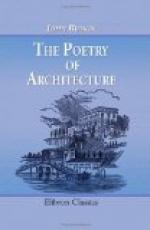[Footnote 33: [A contributor to the “Architectural Magazine."]]
179. Now, there is nothing which requires study so close, or experiment so frequent, as the proper designing of ornament. For its use and position some definite rules may be given; but, when the space and position have been determined, the lines of curvature, the breadth, depth, and sharpness of the shadows to be obtained, the junction of the parts of a group, and the general expression, will present questions for the solution of which the study of years will sometimes scarcely be sufficient;[34] for they depend upon the feeling of the eye and hand, and there is nothing like perfection in decoration, nothing which, in all probability, might not, by farther consideration, be improved. Now, in cases in which the outline and larger masses are determined by situation, the architect will frequently find it necessary to fall back upon his decorations, as the only means of obtaining character; and that which before was an unmeaning lump of jagged freestone, will become a part of expression, an accessory of beautiful design, varied in its form, and delicate in its effect. Then, instead of shrinking from his bits of ornament, as from things which will give him trouble to invent, and will answer no other purpose than that of occupying what would otherwise have looked blank, the designer will view them as an efficient corps de reserve, to be brought up when the eye comes to close quarters with the edifice, to maintain and deepen the impression it has previously received. Much more time will be spent in the conception, much more labor in the execution, of such meaning ornaments, but both will be well spent and well rewarded.
[Footnote 34: For example, we would allow one of the modern builders of Gothic chapels a month of invention, and a botanic garden to work from, with perfect certainty that he would not, at the expiration of the time, be able to present us with one design of leafage equal in beauty to hundreds we could point out in the capitals and niches of Melrose and Roslin.]
180. Perhaps our meaning may be made more clear by Fig. 13 A, which is that of a window found in a domestic building of mixed and corrupt architecture, at Munich (which we give now, because we shall have occasion to allude to it hereafter). Its absurd breadth of molding, so disproportionate to its cornice, renders it excessively ugly, but capable of great variety of effect. It forms one of a range of four, turning an angle, whose moldings join each other, their double breadth being the whole separation of the apertures, which are something more than double squares. Now by alteration of the decoration, and depth of shadow, we have B and C. These three windows differ entirely in their feeling and manner, and are broad examples of such distinctions of style as might be adopted severally in the habitations of the man of imagination, the man of intellect and the man of feeling.[35] If our alterations have been properly




